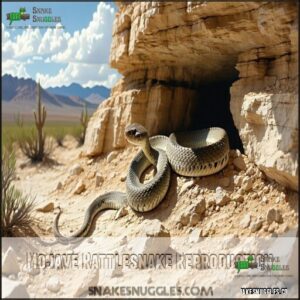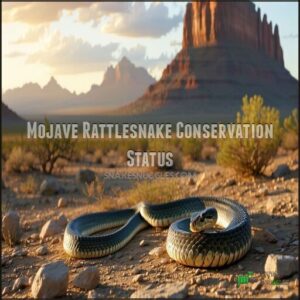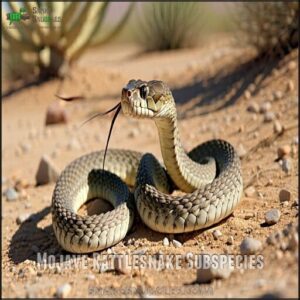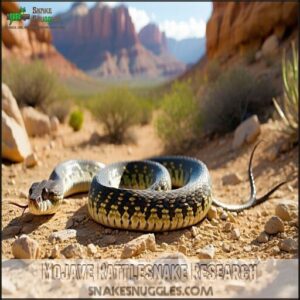This site is supported by our readers. We may earn a commission, at no cost to you, if you purchase through links.
 The Mojave rattlesnake, found in the deserts of the southwestern U.S. and northern Mexico, is one snake you don’t want to ignore.
The Mojave rattlesnake, found in the deserts of the southwestern U.S. and northern Mexico, is one snake you don’t want to ignore.
It’s known for its potent venom, which can pack quite a punch—earning it a top spot among North America’s deadliest snakes.
Recognizable by its pale green to brown body with bold diamond patterns, this snake measures about 3-4 feet long.
It relies on sharp heat-sensing pits to locate prey like rodents and lizards, and has a tail-end rattle, a built-in warning system.
Curious about its behavior, diet, or why it’s nicknamed a "sidewinder’s cousin?" Keep reading to find out.
Table Of Contents
- Where Mojave Rattlesnakes Live
- Mojave Rattlesnake Appearance
- Mojave Rattlesnake Behavior
- Mojave Rattlesnake Venom Toxicity
- Mojave Rattlesnake Diet
- Mojave Rattlesnake Reproduction
- Mojave Rattlesnake Conservation Status
- Mojave Rattlesnake Taxonomy
- Mojave Rattlesnake Subspecies
- Mojave Rattlesnake Research
- Frequently Asked Questions (FAQs)
- Are Mojave rattlesnakes venomous?
- How do Mojave rattlesnake hunt?
- Are Mojave rattlesnakes aggressive?
- Where do Mojave Rattlesnakes live?
- What do Mojave Rattlesnakes eat?
- Do Mojave rattlesnakes chase you?
- Is the Mojave green rattlesnake deadly?
- How do you identify a Mojave rattlesnake?
- What are the different types of Mojave rattlesnakes?
- What is a Mojave rattlesnake called?
- Conclusion
Where Mojave Rattlesnakes Live

The Mojave rattlesnake thrives in some of the harshest landscapes, calling the scorching arid regions of the southwestern United States and northern Mexico home.
Thriving in extreme deserts, the Mojave rattlesnake masters survival where others falter, blending into the harsh arid wilderness.
Its habitat stretches across a vast geographic range, including the Mojave Desert and other rugged environments in California, Arizona, Nevada, and Texas.
With a knack for survival in extreme conditions, this desert reptile prefers open desert habitats filled with rocky outcroppings, scrubby vegetation, and hardy plants like creosote bushes and cacti.
By day, the rattlesnake hides in burrows or among rocks to escape the unforgiving heat. At dawn and dusk, it emerges, blending seamlessly into the Mojave ecosystem.
Spotting one is rare, but be sure to heed its distinctive warning rattle if you do! Understanding rattlesnake habitats is essential for appreciating the adaptability of this species.
Mojave Rattlesnake Appearance
When you spot a Mojave rattlesnake (or Mojave green rattlesnake), its striking body color will grab your attention.
Shades of pale green, brown, gray, or yellowish help this snake blend into its desert surroundings.
Along its back, the iconic dark diamond scale patterns make it unmistakable, while its wide white tail bands (broader than the dark ones) add to its unique look.
The head shape is broad and triangular, with enlarged scales between the eyes, giving it a distinctive profile.
Meanwhile, the skin texture appears rough but serves as perfect camouflage among rocks and scrubby landscapes.
Admire the Mojave rattlesnake’s beauty from afar, but stay cautious—it’s not just its patterns that stand out; its venom packs a punch too!
Mojave Rattlesnake Behavior
Ever wondered how a snake survives in the blazing desert? Discover the answer in the Mojave rattlesnake’s fascinating behavior.
With its nocturnal habits, this predator stays cool by day, hiding in burrows or rocky crevices, and comes alive at night.
Its hunting strategies are all about stealth, using heat-sensing pits and a keen sense of smell to ambush prey like rodents and birds.
When threatened, its defensive tactics kick in—vibrating its iconic rattle and striking swiftly.
You might think it’s all aggression, but Mojave rattlesnake behavior shows remarkable social interactions and adaptive movement patterns, shaped by tough environments.
During winter, it brumates, basically taking a long underground break. These snakes are true desert wildlife survival experts!
Mojave Rattlesnake Venom Toxicity
You don’t want to mess with a Mojave rattlesnake – its venom is among the deadliest in the snake world.
With venom deadlier than most, the Mojave rattlesnake commands respect—one strike could change everything.
This venom isn’t just vicious; it’s a mix of neurotoxic and hemotoxic compounds, like the infamous Mojavetoxin, a neurotoxin that disrupts nerve function.
It attacks your nervous system by blocking acetylcholine release, which can lead to paralysis and other neurotoxic effects.
These rattlesnakes thrive in arid desert habitats.
But there’s more. Its venom also damages muscles and tissues, creating potentially life-threatening complications.
The toxicity variations make it unpredictable, with some bites worse than others depending on the snake’s geographic origin.
Without prompt antivenom treatment, even mild symptoms like swelling and pain can escalate to difficulty breathing or worse – fatality.
Stay sharp and avoid careless encounters. Regarding Mojave rattlesnake venom, ignorance or delay can cost precious time—and maybe a whole lot more.
Mojave Rattlesnake Diet
In the vast Mojave Desert, your diet reflects the art of survival.
You’ve mastered the balance of seasonal Prey Animals by shifting your Foraging Strategies to what’s abundant.
Spring sees you feasting on reptiles, like lizards, while summer brings opportunities to hunt rodents and nesting birds.
You don’t chase; you wait.
Camouflaged near trails or burrows, you ambush at the perfect moment—striking with precision.
Your venom does the heavy lifting, subduing prey quickly and minimizing escape.
It’s lethal, but also efficient, fueling your Metabolic Needs in such a harsh environment.
- Dietary Shifts keep your meals varied for survival.
- Venom’s power helps you tackle prey larger than your head.
- You rarely go hungry, thanks to sharp instincts and patience.
Every meal is a demonstration of your desert dominance.
The Mojave rattlesnake’s venom composition includes presynaptic neurotoxins that play a vital role in immobilizing its prey.
Mojave Rattlesnake Reproduction
In the context of reproduction, Mojave rattlesnakes have a fascinating approach.
The breeding season runs from July through September, giving these snakes a short window to mate.
As ovoviviparous creatures, they bring live offspring into the world instead of laying eggs.
Females, after mating, look for safe rodent burrows to shelter in during their reproductive cycle.
Once the young are born—usually a litter size of 2 to 17—they’re fully formed and ready to take on the desert, measuring about 25 cm long.
Parental care? Forget it.
Mojave rattlesnakes leave their young to fend for themselves the moment they’re born.
It’s a no-nonsense survival strategy fitting for the harsh Southwest.
This independence highlights their resilience as a species, ensuring they thrive despite challenging conditions.
Nature’s tough, but so are these snakes!
They have a unique approach to survival, showcasing their ability to adapt in a harsh environment.
Mojave Rattlesnake Conservation Status
Although the Mojave rattlesnake’s conservation status is Least Concern, this remarkable snake still faces challenges, including habitat loss, climate change, and human impact.
These issues threaten its survival and underscore the need for reptile conservation. It’s necessary to understand the Mojave green rattlesnake’s characteristics to aid in conservation efforts.
To support this species, conservation efforts should focus on key strategies:
- Protecting Habitat: Safeguard desert ecosystems vital to the Mojave green rattlesnake’s survival.
- Reducing Conflict: Educate communities to reduce unnecessary harm to snakes.
- Promoting Research: Expand studies on venom properties and population health.
- Limiting Development: Balance urban growth with wildlife conservation needs.
- Addressing Climate Change: Support policies benefiting desert species’ future outlook.
Small actions guarantee this wildlife icon thrives.
Mojave Rattlesnake Taxonomy
The Mojave rattlesnake, scientifically known as Crotalus scutulatus, has a fascinating place among rattlesnakes. As part of the family Viperidae and the order Squamata, it’s a highly successful desert-dwelling predator. With venom 10 times deadlier than the Western Diamondback, this species carries significant evolutionary intrigue.
Taxonomy reveals the Mojave rattlesnake’s evolutionary history and adaptations to its harsh desert environment. There are two recognized subspecies: C. s. scutulatus and C. s. salvini. These subspecies evolved in isolation, leading to unique venom variations and distinct geographic distributions.
Here’s a quick overview:
Classification Details Scientific Name Family Subspecies Count
Understanding its scientific classification offers valuable insight into this snake’s adaptations and evolutionary story. It’s like reading nature’s secrets in venomous code!
Mojave Rattlesnake Subspecies
The Mojave rattlesnake has two main subspecies: the Scutulatus subspecies (Mojave green rattlesnake) and the Salvini subspecies (Humantlan rattlesnake).
These subspecies showcase fascinating adaptations shaped by their geographic distribution. The Scutulatus subspecies thrives in the deserts of the southwestern U.S. and northern Mexico, sporting lighter colors and narrower bands that blend with dry, arid landscapes.
On the other hand, the Salvini subspecies is found further south, favoring tropical habitats in central Mexico with more pronounced patterns.
One major difference between Mojave rattlesnake subspecies is their venom characteristics. While both are potent, the Mojave green’s venom is infamous for its neurotoxicity, making it a species to respect.
Either way, these rattlers remind you never to underestimate nature’s craftsmanship!
Mojave Rattlesnake Research
You’d be amazed at how much scientists have learned about the Mojave rattlesnake through research.
From venom composition to genetic diversity, each study uncovers facts that shed light on this fascinating yet misunderstood predator.
Venom Variation
Mojave rattlesnakes are masters of venom variation, tailoring their neurotoxic-hemotoxic venom to their environment.
Geographic variation, prey influence, and genetic factors, like venom-specific proteins, shape its incredible potency.
Researchers can purchase mojave rattlesnake venom products for research purposes.
Venom types differ by region, serving as a snake survival strategy, making each Mojave rattlesnake’s venom a unique cocktail of nature’s precision engineering.
PLA2 Diversity
PLA2 diversity in Mojave rattlesnake venom (Crotalus scutulatus) is like nature’s science experiment.
Geographic shifts shape Phospholipase Variants, leading to unique Toxin Diversity.
Here’s what plays a part:
- Enzyme Evolution: Tailoring venom profiles over time.
- Gene Expression: Snake DNA at work!
- Protein Structure: Influencing venom potency.
- Regional prey adaptation.
- Neurotoxic-hemotoxic venom variations.
Understanding the role of PLA2 Enzyme is vital for this understanding.
Myotoxin Diversity
The Mojave rattlesnake’s myotoxin diversity tells a fascinating story of evolution.
Myotoxin structure and enzyme activity vary, with some toxins exclusive to specific venom types, hinting at genetic adaptation.
This venom variation doesn’t always match geography, adding to the mystery.
Such protein diversity reveals how these snakes thrive ecologically, balancing neurotoxic-hemotoxic venom and adapting to diverse prey—true survival experts!
Transcriptome Analysis
Deciphering the secrets of the Mojave green, transcriptome analysis sheds light on its genetic arsenal.
Scientists use tools like RNA sequencing and genome mapping to demystify venom variation and protein coding.
Here’s why it matters:
- Helps develop antivenoms suited to venom complexity.
- Advances molecular biology by exploring genes tied to PLA2 and myotoxin diversity.
- Reveals how the Mojave green thrives in harsh deserts.
Understanding this genetic roadmap protects both us and these remarkable vipers.
The study of snake transcriptome involves analyzing snake transcriptome data to better comprehend the nuances of venom production.
Frequently Asked Questions (FAQs)
Are Mojave rattlesnakes venomous?
Yes, they’re highly venomous and pack a serious punch with their neurotoxic-hemotoxic venom.
A bite can cause severe symptoms, so always keep your distance—this isn’t a snake you want to mess with!
How do Mojave rattlesnake hunt?
Picture a stealthy desert ninja.
They lie perfectly still, blending into the sand, using heat-sensing pits to detect prey.
At dawn or dusk, they strike fast and precise, capturing rodents or lizards with venomous fangs.
Are Mojave rattlesnakes aggressive?
Mojave rattlesnakes aren’t naturally aggressive, but they’ll defend themselves fiercely if threatened.
They’d rather slither away unnoticed, but disturb one, and you’ll hear their rattling warning—a desert snake’s polite way of saying, “Back off, buddy!”
Where do Mojave Rattlesnakes live?
You’ll find Mojave rattlesnakes in the arid deserts of the southwestern U.S. and northern Mexico.
They favor sun-baked habitats with sparse vegetation, like scrublands, cacti-filled flats, and rocky outcrops, mostly avoiding densely forested areas.
What do Mojave Rattlesnakes eat?
Did you know Mojave rattlesnakes mostly feast on small rodents like kangaroo rats?
They also hunt birds, lizards, and even insects.
Using their heat-sensing pits, they strike with precision, making them efficient nighttime hunters!
Do Mojave rattlesnakes chase you?
They won’t chase you—they’re more about avoiding trouble.
If threatened, they’ll defend themselves with a rattle warning and a strike if necessary.
Stay calm, give them space, and everyone walks away unharmed—no drama.
Is the Mojave green rattlesnake deadly?
With venom 10 times more potent than the Western Diamondback, the Mojave green rattlesnake is deadly.
Its neurotoxic venom can paralyze muscles and affect breathing.
Stay cautious—this snake’s bite demands immediate medical attention.
How do you identify a Mojave rattlesnake?
You’ll spot a Mojave rattlesnake by its pale green to brown body, diamond-patterned back, triangular head, and thick white tail bands.
Its distinctive rattle warns, “Stay back!”—a sound you definitely don’t want to ignore.
What are the different types of Mojave rattlesnakes?
Think of Mojave rattlesnakes as desert royalty with two lineages: the neurotoxic C. scutulatus scutulatus in the U.S. and northern Mexico and the southern C. scutulatus salvini.
Their venom makes them formidable yet fascinating.
What is a Mojave rattlesnake called?
A Mojave rattlesnake is often called a "Mojave green" due to its greenish tint.
Its scientific name is Crotalus scutulatus, and it’s famous (or infamous) for its potent venom and distinct rattle warning.
Conclusion
Picture the sun-soaked, dry deserts where the Mojave rattlesnake silently slithers, embodying stealth and nature’s complexity.
This species profile reveals a fascinating predator equipped with potent venom, heat-sensing pits, and a signature rattle.
From its bold patterns to its unique behaviors, the Mojave rattlesnake thrives as hunter and survivor.
Whether it’s adapting to its arid habitat or contributing to venom research, this snake highlights the delicate balance of life in desert ecosystems.
Respect it, but don’t underestimate it.













